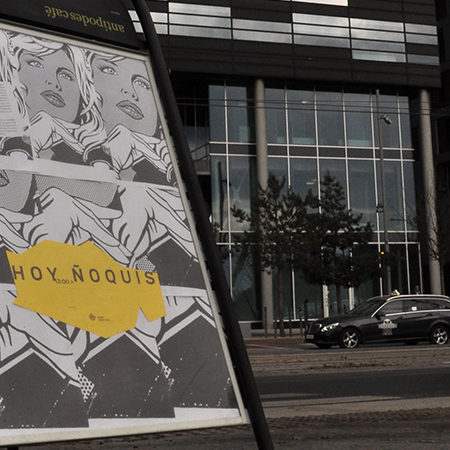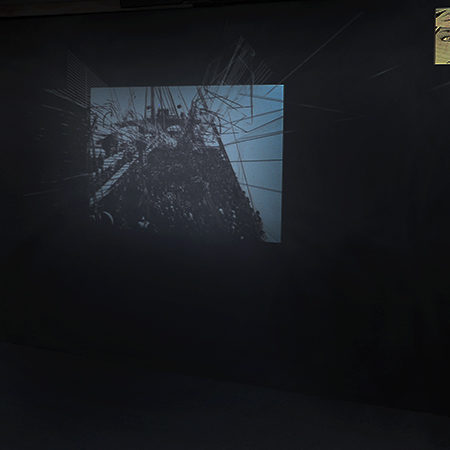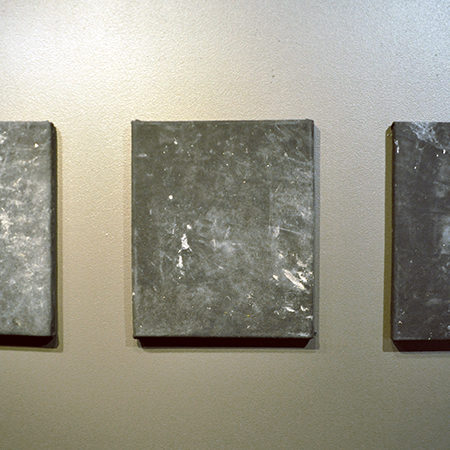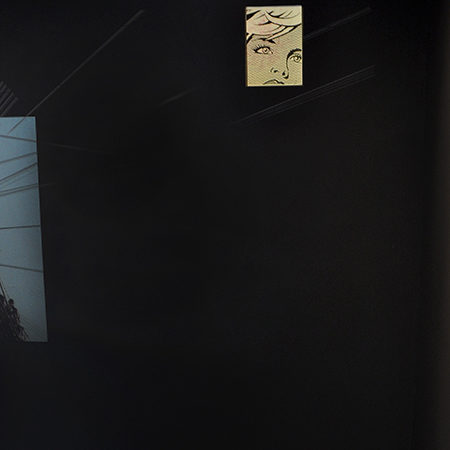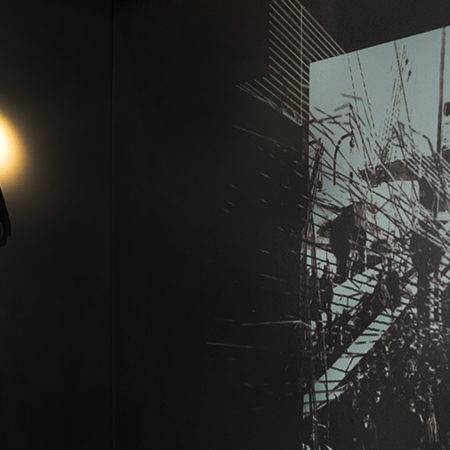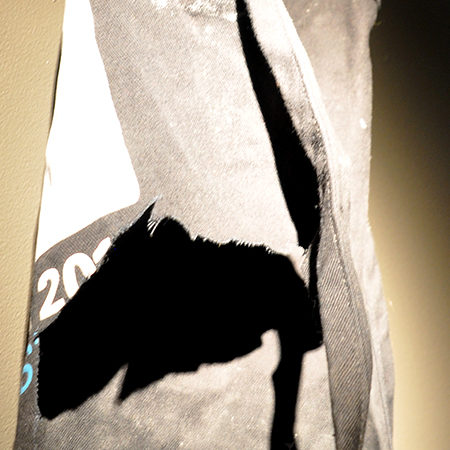Overview
- Kategori Utstilling / Ting / antipodes café DEG15 / HOY ÑOQUIS
- Location / Region Norge/ Oslo
- Fra 2016.11.29
- Til 2016.11.29
Description
Utstillingen utviklet på den siste dagen av “HOY ÑOQUIS” på antipodes café DEG15 var basert på en installasjon som inkluderte en projeksjon av et stillbilde plassert mellom resten av en forkle og tre rammer – laget med det forkleet. I tillegg var det en plakat utenfor stedet.
Siden det var en 29. gnocchi, ble det tilberedt og delt med alle besøkende.
Projeksjon
Stille bilde av en båt full av italienske utvandrere som reiser til Sør-Amerika, med linjer som er følsomme for lyden av omgivelsene.
Forkle
Forkleet var en gave vi fikk tidlig i juni 2014 fra Organisasjonen for San Sebastian som Europeisk kulturhovedstad i 2016. Denne merchandisinggaven var i svart stoff og inkluderte logoen for arrangementet silketrykt med to blekkfarger på forsiden.
Det ble alltid brukt med baksiden frem, kun for å lage gnocchi frem til 29. oktober 2016, og ble aldri vasket.
3 Rammer
Vi erstattet det hvite stoffet på 3 klare, ca. A4 lerret med det svarte stoffet fra nevnte forkle som en påminnelse om de 3 årene med samlingene “HOY ÑOQUIS”.
Plakat
Collage som bruker 9 av 10 unike kopier laget i 2007 i Uruguay og et gult papir trykt med teksten “HOY ÑOQUIS” skåret i en uregelmessig form. Kopiene er 9 forstørrelser av 1 forstørrelseskopiering av en illustrasjon trykt på forsiden av det nå nedlagte magasinet “Deustchland” støttet av det tyske utenriksdepartementet. Illustrasjonen – som minner om jenta fra “M-Maybe” av Lichtenstein – er et halvtonetrykt ansikt av en kaukasisk kvinne med langt hår – mest sannsynlig blondt -, lyse fargeøyne og en hånd med en hvit hanske i en posisjon som antyder tenking.
En av papirene inkluderer en fotokopi av en uruguayansk mynt, og et annet papir inkluderer avsnitt 49 og 50 – på spansk – fra Guy Debords bok “The Society of the Spectacle”:
“49.
The spectacle is the flip side of money. It, too, is an abstract general equivalent of all commodities. But whereas money has dominated society
as the representation of universal equivalence — the exchangeability of different goods whose uses remain uncomparable — the spectacle is the modern complement of money: a representation of the commodity world as a whole which serves as a general equivalent for what the entire society can be and can do. The spectacle is money one can only look at, because in it all use has already been exchanged for the totality of abstract representation. The spectacle is not just a servant of pseudo-use, it is already in itself a pseudo-use of life.
50.
With the achievement of economic abundance, the concentrated result of social labor becomes visible, subjecting all reality to the appearances that are now that labor’s primary product. Capital is no longer the invisible center governing the production process; as it accumulates, it spreads to the ends of the earth in the form of tangible objects. The entire expanse of society is its portrait.”
G.E.D. [oversatt av Ken Knabb (kilde)]
Plakat, forkle og rammer ble utstilt i showet “antipodes café visits Elefante” i Brasília, 2017.
In Uruguay and Argentina, there is a tradition of eating handmade gnocchi the 29th of each month, both in houses and in restaurants. In these last ones, as well as in pasta stores, those days they usually put a sign in the street with the text "HOY ÑOQUIS" (Eng. Today: gnocchi).
Also as part of the tradition, in some places they put a coin (or even notes) under the dish, wishing for money.
This story -that has many versions as all good ones- perhaps should be started highlighting the travel of potatoes from South America to the rest of the world, starting with Europe after their invasion. Later on, poor farmers of northern Italy discovered that they can replace expensive wheat to create a new kind of pasta based on cheap and accessible potatoes, basically dumplings, called gnocchi (Eng. buns/lumps/little balls). This tuber crops has a strong relation with economical vicissitudes, saving from starving diverse populations around the world. Nordic countries knows quite well potatoes for that reason.
In late XIX and beginning of XX centuries, both Argentina and Uruguay where under exponential growth in all senses. But in these times, Europeans weren't in best situation, and particularly Italians flew in millions to those places escaping from economical crisis and wars. Those nations where young and defining their identity on daily basis, and this massive immigration radically affected that construction "through a policy of very strong cultural syncretism." In fact, "there are many Italian traditions that Argentinians [and Uruguayans] keep which are almost not existent in Italy." * One of them is to eat gnocchi on the 29th of each month. A simple dish for wishing for prosperity.
Felipe, born in Uruguay has in his family tree those Italians roots that allowed him to have Italian nationality. And thanks for those papers, he could move to Nordic countries without too many complications as if he arrived just as the South American he is.
Since he moved to Norway, impressed by
- the short time that the old Kingdom behaves as a totally independent nation;
- its quite recent and extreme economical richness (with its abundance);
- history of extreme poverty -not so far in time– still present in many gestures of raw simplicity and austerity;
- the potato is easily cultivated in Norwegian climate and soil;
- role of potatoes in history, saving population in hard times such as during Napoleonic wars or WWII, both in dishes and in glasses;
- the current displacement of potatoes towards modern imports such as rice, pasta and noodles;
- the strong policy against immigration;
- the apathy towards the foreign and the unknown, certified by the law of Jante from 1933;
- the commercial new traditions, such as eating taco on Friday nights or reading crime novels on April.
Felipe started cooking gnocchi sporadically the 29th -and last years on each one- in gathering with the aim of talking about traditions. Who makes them? why? and so on…
Venues and amount of visitors are different from meeting to meeting, but gnocchi are always served gratuitously. During 2016 "HOY ÑOQUIS" gatherings were supported by Oslo Kommune, Bydel Gamle Oslo. (Frivillighetsmidler 2016)

